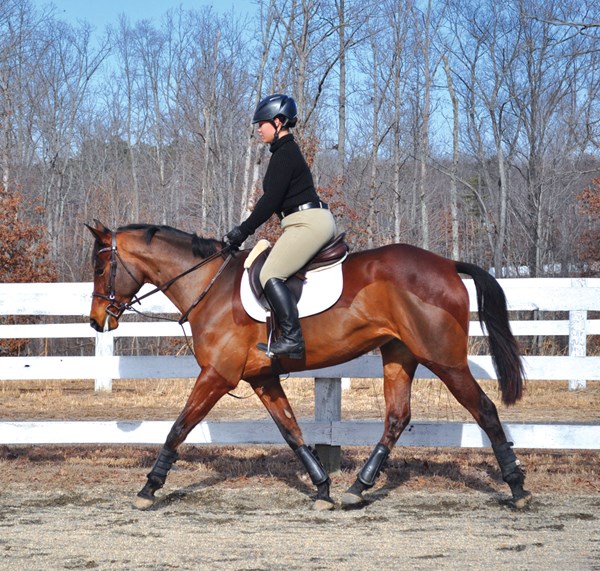
This is Kymberly Williams and her 6-year-old Quarter Horse mare, Baby. Kymberly has ridden her for only seven months and trains in both dressage and hunters. She has had some trouble teaching Baby to accept contact, but says it has improved.
This is a happy horse that moves well, and Kymberly is doing a good job of being cautious with the rein contact. When Kymberly first started riding her, Baby would really duck behind the vertical and curl up when she felt the rein. In this photo, Baby is reaching up and out nicely with her neck from the base into the bridle. Her poll is correctly at the highest point. The bottom line of her neck is shorter than the top line, which is a very desirable proportion.
The balance in this picture is slightly deceiving. At first glance, Baby seems to be on the forehand, but I think it’s just because she is built a little high in her hind end. Many Quarter Horses have this conformation, but it doesn’t make them any less athletic. She will learn how to lower her croup throughout systematic training, but at this level, she is fine. It appears, at first, that Baby isn’t engaged enough, but actually when you see the amount of ground she’s covering with her hind legs compared to her front legs, you cannot say she needs more engagement for this level. Her front and hind legs match exactly and she’s tracking up well. She looks fairly free in her shoulder for this level, and has a nice lift from the base of her neck. I am quite happy with her in this moment.
Kymberly may be able to help her mare advance and become more supple by changing a few things in her body. I am assuming that she is in posting trot in this picture. I like that her shoulder is in line with her knee, even at the bottom of the rise. But I would like to see her knee more bent and slightly farther back so there isn’t as much push against the stirrup. When her leg is in the correct placement, it should give the appearance that she could keep her balance if you erased Baby from the photo and Kymberly were standing on her own feet. The way Kymberly pushes in the stirrup is the reason, I think, she looks like she’s too tentative.
Kymberly could increase her effectiveness by pushing her rib cage a little more back by engaging her abdominal muscles so that her core strength was greater and her back more filled in. I really like that Kymberly’s hands are not trying to pull her mare’s head down in that they’re in a direct line from her elbow to the horse’s mouth.











